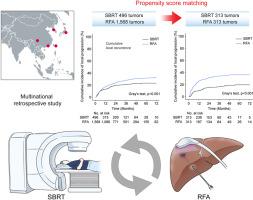当前位置:
X-MOL 学术
›
J. Hepatol.
›
论文详情
Our official English website, www.x-mol.net, welcomes your
feedback! (Note: you will need to create a separate account there.)
Stereotactic body radiation therapy vs. radiofrequency ablation in Asian patients with hepatocellular carcinoma
Journal of Hepatology ( IF 26.8 ) Pub Date : 2020-03-10 , DOI: 10.1016/j.jhep.2020.03.005 Nalee Kim , Jason Cheng , Inkyung Jung , Ja Der Liang , Yu Lueng Shih , Wen-Yen Huang , Tomoki Kimura , Victor H.F. Lee , Zhao Chong Zeng , Ren Zhenggan , Chul Seung Kay , Seok Jae Heo , Jong Yoon Won , Jinsil Seong
Journal of Hepatology ( IF 26.8 ) Pub Date : 2020-03-10 , DOI: 10.1016/j.jhep.2020.03.005 Nalee Kim , Jason Cheng , Inkyung Jung , Ja Der Liang , Yu Lueng Shih , Wen-Yen Huang , Tomoki Kimura , Victor H.F. Lee , Zhao Chong Zeng , Ren Zhenggan , Chul Seung Kay , Seok Jae Heo , Jong Yoon Won , Jinsil Seong

|
Few studies have been conducted to compare the efficacies of stereotactic body radiation therapy (SBRT) and radiofrequency ablation (RFA). Thus, in this multinational study, we compared the effectiveness of SBRT and RFA in patients with unresectable HCC. The retrospective study cohort included 2,064 patients treated in 7 hospitals: 1,568 and 496 in the RFA and SBRT groups, respectively. More than half of the patients (56.5%) developed recurrent tumors, mainly after transarterial chemoembolization (44.8%). Propensity score matching was performed to adjust for clinical factors (n = 313 in each group). At baseline, the SBRT group had unfavorable clinical features compared to the RFA group, including BCLC stage (B-C 65% 16%), tumor size (median 3.0 cm 1.9 cm), and frequent history of liver-directed treatment (81% 49%, all <0.001). With a median follow-up of 27.7 months, the 3-year cumulative local recurrence rates in the SBRT and RFA groups were 21.2% and 27.9%, respectively ( <0.001). After adjusting for clinical factors, SBRT was related to a significantly lower risk of local recurrence than RFA in both the entire (hazard ratio [HR] 0.45, <0.001) and matched (HR 0.36, <0.001) cohorts. In subgroup analysis, SBRT was associated with superior local control in small tumors (≤3 cm) irrespective of location, large tumors located in the subphrenic region, and those that progressed after transarterial chemoembolization. Acute grade ≥3 toxicities occurred in 1.6% and 2.6% of the SBRT and RFA patients, respectively ( = 0.268). SBRT could be an effective alternative to RFA for unresectable HCC, particularly for larger tumors (>3 cm) in a subphrenic location and tumors that have progressed after transarterial chemoembolization. It is currently not known what the best treatment option is for patients with unresectable hepatocellular carcinoma. Here, we show that stereotactic body radiation therapy provides better local control than radiofrequency ablation, with comparable toxicities. Stereotactic body radiation therapy appears to be an effective alternative to radiofrequency ablation that should be considered when there is a higher risk of local recurrence or toxicity after radiofrequency ablation.
中文翻译:

亚洲肝细胞癌患者的立体定向全身放射治疗与射频消融治疗
很少有研究来比较立体定向放射治疗 (SBRT) 和射频消融 (RFA) 的疗效。因此,在这项跨国研究中,我们比较了 SBRT 和 RFA 对不可切除的 HCC 患者的有效性。回顾性研究队列包括在 7 家医院接受治疗的 2,064 名患者:RFA 组和 SBRT 组分别为 1,568 名和 496 名患者。超过一半的患者(56.5%)出现肿瘤复发,主要是在经动脉化疗栓塞术后(44.8%)。进行倾向评分匹配以调整临床因素(每组 n = 313)。在基线时,与 RFA 组相比,SBRT 组具有不利的临床特征,包括 BCLC 分期(B-C 65% 16%)、肿瘤大小(中位 3.0 cm × 1.9 cm)以及频繁的肝脏定向治疗史(81% 49%) ,全部<0.001)。中位随访时间为 27.7 个月,SBRT 组和 RFA 组的 3 年累积局部复发率分别为 21.2% 和 27.9%(<0.001)。调整临床因素后,在整个队列(风险比 [HR] 0.45,<0.001)和匹配队列(HR 0.36,<0.001)中,SBRT 与局部复发风险显着低于 RFA 相关。在亚组分析中,无论位置如何,SBRT 与小肿瘤(≤3 cm)、位于膈下区域的大肿瘤以及经动脉化疗栓塞后进展的肿瘤的良好局部控制相关。 SBRT 和 RFA 患者的急性 3 级以上毒性发生率分别为 1.6% 和 2.6% (= 0.268)。对于不可切除的 HCC,SBRT 可能是 RFA 的有效替代方案,特别是对于膈下位置的较大肿瘤(> 3 cm)以及经动脉化疗栓塞后进展的肿瘤。 目前尚不清楚对于不可切除的肝细胞癌患者的最佳治疗选择是什么。在这里,我们表明立体定向身体放射治疗比射频消融提供更好的局部控制,并且具有类似的毒性。立体定向身体放射治疗似乎是射频消融的有效替代方案,当射频消融后局部复发或毒性风险较高时,应考虑采用立体定向放射治疗。
更新日期:2020-03-10
中文翻译:

亚洲肝细胞癌患者的立体定向全身放射治疗与射频消融治疗
很少有研究来比较立体定向放射治疗 (SBRT) 和射频消融 (RFA) 的疗效。因此,在这项跨国研究中,我们比较了 SBRT 和 RFA 对不可切除的 HCC 患者的有效性。回顾性研究队列包括在 7 家医院接受治疗的 2,064 名患者:RFA 组和 SBRT 组分别为 1,568 名和 496 名患者。超过一半的患者(56.5%)出现肿瘤复发,主要是在经动脉化疗栓塞术后(44.8%)。进行倾向评分匹配以调整临床因素(每组 n = 313)。在基线时,与 RFA 组相比,SBRT 组具有不利的临床特征,包括 BCLC 分期(B-C 65% 16%)、肿瘤大小(中位 3.0 cm × 1.9 cm)以及频繁的肝脏定向治疗史(81% 49%) ,全部<0.001)。中位随访时间为 27.7 个月,SBRT 组和 RFA 组的 3 年累积局部复发率分别为 21.2% 和 27.9%(<0.001)。调整临床因素后,在整个队列(风险比 [HR] 0.45,<0.001)和匹配队列(HR 0.36,<0.001)中,SBRT 与局部复发风险显着低于 RFA 相关。在亚组分析中,无论位置如何,SBRT 与小肿瘤(≤3 cm)、位于膈下区域的大肿瘤以及经动脉化疗栓塞后进展的肿瘤的良好局部控制相关。 SBRT 和 RFA 患者的急性 3 级以上毒性发生率分别为 1.6% 和 2.6% (= 0.268)。对于不可切除的 HCC,SBRT 可能是 RFA 的有效替代方案,特别是对于膈下位置的较大肿瘤(> 3 cm)以及经动脉化疗栓塞后进展的肿瘤。 目前尚不清楚对于不可切除的肝细胞癌患者的最佳治疗选择是什么。在这里,我们表明立体定向身体放射治疗比射频消融提供更好的局部控制,并且具有类似的毒性。立体定向身体放射治疗似乎是射频消融的有效替代方案,当射频消融后局部复发或毒性风险较高时,应考虑采用立体定向放射治疗。











































 京公网安备 11010802027423号
京公网安备 11010802027423号